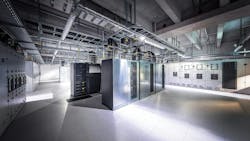The Growing Need for Energy-Efficient Cooling in Data Centers
With the exponential expansion of AI computing, the need for efficient cooling mechanisms within data centers has reached a critical juncture. As AI applications become more pervasive across diverse industries, data centers are undergoing unprecedented growth in scale and complexity. However, this growth accompanies a significant drawback—heightened heat generation. Therefore, we also need scalable and energy-efficient cooling solutions to handle this increasingly important sector.
Efficient cooling solutions play a crucial role in mitigating the environmental impact of data centers. By adopting highly efficient EC technology, data center operators can achieve substantial energy savings and reduce their carbon footprint. In fact, over the next five years, such efforts in the data center sector could save up to four megatons of CO2 emissions, contributing to a more sustainable future.
Understanding Data Center Cooling
So, the implementation of efficient data center cooling is important, but how does it work? Whether it is air-to-air, liquid-to-air, or the most modern liquid-to-liquid systems, energy-efficient fans are typically necessary for heat exchange within the facility. The process involves the exchange of hot air with cooler air. While seemingly simple, there are diverse approaches to this essential task, with new techniques continually emerging to create more energy-efficient and cost-effective data center facilities capable of supporting complex colocation and hyperscale strategies.
Every data center presents unique challenges and requirements. Companies like ebm-papst offer a wide range of cooling solutions to meet specific facility needs, including cooling individual server rows, implementing modular designs, inclusion in dry coolers, or integrating cooling towers. Some fan types are more suitable for certain situations, such as:
- Axial fans are increasingly used in data centers located near industrial or residential areas to comply with noise protection regulations. For example, ebm-papst’s AxiBlade emphasizes high power density with low noise emissions, while AxiEco is suitable for applications requiring high-pressure increases.
- Centrifugal fans are also prevalent in this sector. Specialized designs, such as the RadiPac series, optimize airflow characteristics to reduce energy consumption and work especially well in fan arrays. These fans operate within broad speed ranges, enabling energy savings across a diverse range of operating conditions.
Enhanced Reliability through Resonance Detection
Depending on how they're installed, any fan can experience resonance within certain speed ranges. This resonance can harm the fan's bearings, causing premature failure. While operators can detect these vibrations, they can't easily eliminate them.
That’s where automatic resonance detection comes in. This feature stops fans from running at critical speeds, extending their lifespan and reliability. During product commissioning, a test startup is conducted to analyze vibration speeds across the entire speed range, from standstill to maximum speed. If excessive vibrations are found in specific ranges, the control software adjusts itself, avoiding those speeds in the future. Operators can also manually adjust the software settings, giving them full control. Additionally, a built-in vibration sensor supports condition monitoring, allowing for better planning of preventive maintenance and service tasks. Furthermore, this feature, which is offered by ebm-papst, can be seamlessly incorporated into a routine preventative maintenance schedule within the building management system or data center infrastructure system, allowing for full automation.
Fan Cooling in Action: A Real-World Example
NTT Global Data Centers EMEA GmbH, a top IT service provider with four data center sites in Frankfurt, Germany, exemplifies the integration of efficient cooling solutions. Its Frankfurt 1 campus is one of Europe's largest, spanning 540,000 square feet of IT space. Precision air-conditioning units maintain the ideal temperature by drawing in warm air, cooling it to 73–75°F, and directing it to server racks through a raised floor. Each air conditioner is equipped with three EC centrifugal fans from the ebm-papst RadiPac series, in operation for almost a decade.
An interesting feature is the standby air-conditioning units, which run at low speeds in parallel for redundancy and efficiency. The fan speed adjusts automatically based on precise pressure control, resulting in a 30% reduction in power consumption. This setup enhances fan lifespan and efficiency, contributing to a good Energy Efficiency Ratio (EER) value.
Keeping the Future Cool
As data centers evolve to accommodate the demands of AI computing, the importance of efficient cooling solutions will only escalate. Navigating the challenges of this AI-driven landscape entails a commitment to building a more efficient and sustainable future for data centers.
About the Author

Joe Landrette
Joe Landrette is the Senior Director of Ventilation/Air Conditioning, Data Center Markets, and Digital Solutions for ebm-papst Inc. Representing North and South America, ebm-papst Inc. is a key subsidiary of the globally renowned ebm-papst Group—the world’s leading manufacturer of fans and motors. ebm-papst Inc. can provide air movement solutions for the data center market with an array of highly efficient products.



